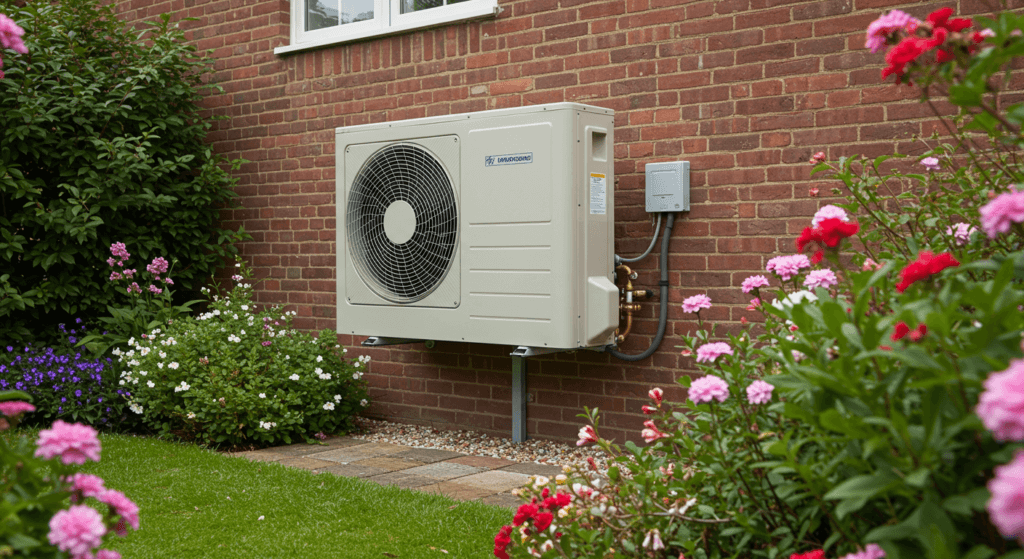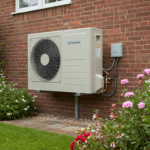Class G – Air source heat pumps & air conditioning on domestic premises
The permitted development right of Class G allows you to install, alter or replace an air source heat pump (ASHP) on a residential property without planning permission. This can be a house, bungalow or a block of flats. You are permitted to install it either on the property itself or within the curtilage.
On the 29th May 2025. Class G was altered to relax the rules around Air Source Heat Pumps (ASHP). This applies to any units installed on or after this date.
You can now have up to two air source heat pumps (ASHP) on a detached house or bungalow, however you are still limited to one on a semi or terraced property or a block of flats. A block of flats is any number provided that it is solely flats. It is two flats or more.
Within a dwellinghouse, whether that is detached, semi or terraced you can now go up to 1.5 cubic metres in size. For flats you are still limited to 0.6 cubic metres. Any air source heat pump needs to still be 1m away from the edge if on a flat roof, but there is now no limit as to how close to the boundary it can be.
Finally and maybe the biggest change is that you can now have a combined heating and cooling unit. Previously the unit had to be capable of heating only. This had ruled out any form of air conditioning units under permitted development. As long as the unit are not solely for cooling you are good to go.
Note that these units on commercial units, will require planning permission.

How do I apply for permission?
You do not need to request permission, Class G is your permission. However there are a few restrictions that you need to be aware of so that you do not fall foul of the conditions within the second part of Class G.
The air source heat pump must comply with the Microgeneration Certification Scheme (MCS). Prior to 29th May 2025 you could have used an equivalent standard. However if this is already planned you can continue to use alternative standards until 28th May 2026. The standard for ASHP can be found here.
You can’t install an air source heat pump if you already have a wind turbine. It must also not be on a pitched roof or within 1 metre of the edge of a flat roof but it can be on a flat roof.
You can’t install an air source heat pump in a listed building or scheduled monument without planning permission. If you are in a conservation area or on a World Heritage Site you can’t install it on an elevation that fronts a highway. You are allowed to install it on the front wall of a property, which is not in a conservation area or on a World Heritage Site but it must be on the ground floor storey and not above. The full legislation can be seen below.
Air Conditioning Units
Following the change in May 2025 you can now have combined heating and cooling units. You cannot have a purely air conditioning unit. It must be combined with an Air Source Heat Pump.
Previously any form of air conditioning unit was not permitted development.
One important factor is that if the unit was installed before 29th May 2025 it will not be permitted development, even if it is a combined unit. This change is not retrospective.
Planning Geek can also assist with a planning application for an Air Conditioning (AC) unit if required. Complete our fee proposal form here.
Air Source Heat Pump Legislation
Class G – installation or alteration etc of air source heat pumps on domestic premises
Permitted Development
G. The installation, alteration or replacement of a microgeneration air source heat pump—
(a) on a dwellinghouse or a block of flats; or
(b) within the curtilage of a dwellinghouse or a block of flats, including on a building within that curtilage.
Development not permitted
G.1 Development is not permitted by Class G unless the air source heat pump complies with the MCS Planning Standards.
G.2 Development is not permitted by Class G if—
(a) in the case of the installation of an air source heat pump, the development would result in the presence of more —
(i) more than one air source heat pump on, or within the curtilage of—
(aa) a dwellinghouse which is not a detached dwellinghouse;
(bb) a block of flats;
(ii) more than two air source heat pumps on, or within the curtilage of, a detached dwellinghouse;
(b) in the case of the installation of an air source heat pump, a wind turbine is installed on the same building or within the curtilage of the dwellinghouse or block of flats
(c) in the case of the installation of an air source heat pump, a stand-alone wind turbine is installed within the curtilage of the dwellinghouse or block of flats;
(d) the volume of the air source heat pump’s outdoor compressor unit (including any housing) would—
(i) in the case of the installation of an air source heat pump on, or within the curtilage of, a dwellinghouse, exceed 1.5 cubic metres;
(ii) in the case of the installation of an air source heat pump on, or within the curtilage of, a block of flats, exceed 0.6 cubic metres;
(f) the air source heat pump would be installed on a pitched roof;
(g) the air source heat pump would be installed on a flat roof where it would be within 1 metre of the external edge of that roof;
(h) the air source heat pump would be installed on a site designated as a scheduled monument;
(i) the air source heat pump would be installed on a building or on land within the curtilage of the dwellinghouse or the block of flats if the dwellinghouse or the block of flats is a listed building;
(j) in the case of land within a conservation area or which is a World Heritage Site the air source heat pump—
(i) would be installed on a wall or a roof which fronts a highway; or
(ii) would be installed so that it is nearer to any highway which bounds the curtilage than the part of the dwellinghouse or block of flats which is nearest to that highway; or
(k) in the case of land, other than land within a conservation area or which is a World Heritage Site, the air source heat pump would be installed on a wall of a dwellinghouse or block of flats if—
(i) that wall fronts a highway; and
(ii) the air source heat pump would be installed on any part of that wall which is above the level of the ground floor storey.
Conditions
G.3 Development is permitted by Class G subject to the following conditions—
(aa) the air source heat pump is not solely used for the purpose of cooling;
(b) the air source heat pump is, so far as practicable, sited so as to minimise its effect on the external appearance of the building;
(c) the air source heat pump is, so far as practicable, sited so as to minimise its effect on the amenity of the area; and
(d) the air source heat pump is removed as soon as reasonably practicable when no longer needed.
Transitional provision
(1) Paragraph (2) applies where development (“previously permitted development”)—
(a) is permitted under Class G of Part 14 of Schedule 2 to the GPDO immediately before 29th May 2025, and
(b) is, by virtue of the amendment made by article 5(2), no longer permitted under that Class on and after 29th May 2025.
(2) Where this paragraph applies, a developer may, despite the amendments made by article 5(2), carry out previously permitted development until the end of 28th May 2026.
Page Updated: 29th May 2025



